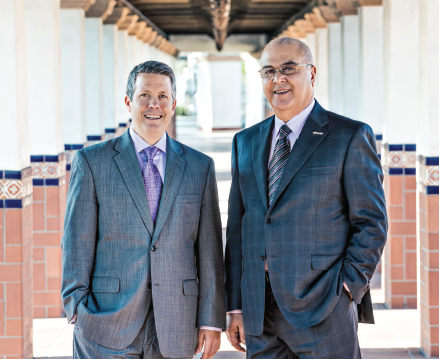
Having built a reputation for its keen understanding of and nimble responses to customers through its delivery of industry-leading analytics to the real estate market, Veros Real Estate Solutions today is transforming the way risk is assessed in the mortgage industry, from appraisers to capital investors. Helmed by founders Darius Bozorgi, president and CEO, and Bijan Bozorgi, CFO and chairman, Veros has quickly risen to the top of its game in no small part because of its largely behind-the-scenes success in transforming how Fannie Mae and Freddie Mac evaluate the quality of loans they guarantee.
Veros is the official technology provider for the oft-touted but perhaps little understood Uniform Collateral Data Portal (UCDP) that has automated, streamlined, and standardized the way the government-sponsored enterprises handle appraisal data. No longer do the GSEs rely on the sometimes-faulty representations and warranties that helped fuel the housing crisis in order to determine whether or not a pool of securitized loans is safe for purchase or guarantee. Thanks to its relationship with Veros, the firms now have verified appraisal data in hand before they buy a loan, not, as previously, only once a loan has gone into default. Veros is also in the process of developing a similar delivery method for the Federal Housing Administration known as the Electronic Appraisal Delivery (EAD) portal.
FUTURE CRISIS PREVENTION THROUGH AUTOMATION
Fortuitously, a new impact player was brought into the Veros fold, and its industry-altering work with Fannie and Freddie strengthened when Charles Rumfola, who spent 20 years at Fannie, joined Veros as senior vice president. Rumfola was at Fannie in the midst of the mortgage meltdown and led the Loan Quality Initiative, which was designed to fix the internal problems that contributed to the large credit losses that led to conservatorship. “Fannie was trying to figure out how to stop the bleeding,” he says. “Both Fannie and Freddie were losing a tremendous amount of money.” The result of that was a $187 billion taxpayer bailout from the U.S. Treasury.
That was then.
Now the two companies have soared back into profitability. Fannie Mae posted its 11th consecutive quarter of profitability with a net income for the third quarter of $3.9 billion and a positive net worth of $6.4 billion. Freddie has experienced its 12th consecutive quarter of positive gains, posting third-quarter net income of $2.1 billion and a net worth of $5.2 billion.
How did they do it?
Rumfola gives a fair amount of credit to Veros and the cooperative relationship it developed with the two GSEs. When Rumfola was still at Fannie, he says the firm was trying to stem the bleeding from massive loan defaults by overhauling the way it did business. First Fannie worked to reduce the frequency of defaults. This was mainly done by making policy changes — raising minimum credit scores for borrowers, requiring 5% down payments on new loans, charging higher prices for high-risk loans and eliminating low-documentation loans. Secondly, the company began to look at the severity of defaults, or how much money was lost when a loan went bad. “To deal with the severity of default required a focus on appraisal quality,” Rumfola explains.
To that end, Veros stepped in to build a whole new infrastructure for Fannie and Freddie to collect electronic appraisal data. “It has enabled the GSEs to take a giant step forward in valuing collateral,” Rumfola says.
He says so many homeowners were (and still are) underwater on their mortgages because of the inflated valuations that were common leading up to the mortgage meltdown. “The GSEs had to figure out how to make sure loan values were accurate,” he adds. To do that, the GSEs took a long look at the appraisal forms and started standardizing key data sets. For example, they added fields about the property condition and quality with six specific detailed definitions or choices from which to select. No longer was a subjective “good” or “average” going to suit. The goal was to standardize and collect the key appraisal data elements that could be used for risk modeling and analytics.
“We made it so everyone was speaking the same language,” Rumfola explains. That language is the Uniform Appraisal Dataset (UAD). Between the GSEs creating the standardized appraisal data and Veros building UCDP, the GSEs changed the infrastructure to manage collateral risk that they were unable to do previously.
Fannie and Freddie adopted the UAD in September 2011. Now the Department of Veterans Affairs and the Federal Housing Administration have adopted it as well. UAD has truly become the industry standard.
“The GSEs wanted appraisal data before they bought the loans,” Rumfola notes. The UCDP creates a mechanism for lenders to submit data to the GSEs and also checks to make sure the standards are met. “By the time the data gets through to the GSEs, everyone is assured the appraisal is complete and meets the appraisal standard,” he adds.
The Federal Housing Finance Agency, the GSEs’ conservator, mandated lenders’ use of the portal in March 2012. Since then more than 20 million appraisals have come through the portal. That means Fannie and Freddie can instantly check a new appraisal against data that’s already in the system.
“It’s all automated,” Rumfola says. “Now that this system is in place, the GSEs can check 100% of appraisals against the database and can instantaneously detect issues that may exist with the loans.”
 INDUSTRY GAME CHANGERS
INDUSTRY GAME CHANGERS
Rumfola says the UCDP has been a game changer. “The GSEs can now have a dialogue with the lender during the loan manufacturing process,” he remarks. “Before, everything was based on the reps and warranties model.”
The system is also changing the way appraisers do their jobs. And overall, after some initial doubt, Rumfola feels the appraisal industry has embraced the change. “Equity is a huge driver in the credit performance of loans,” says Rumfola.“The work that appraisers do has an impact on loan performance.”
Veros’ enterprise risk management solutions for the GSEs as well as FHA are also changing the market by increasing loan availability. While many industry analysts have criticized FHFA Director Mel Watt’s announcement that Fannie and Freddie would begin offering loans with down payments of as little as 3%, Rumfola says the work on appraisals is making it possible to offer these otherwise higher-risk loans.
“Our work has allowed the GSEs to go back to 97% loan-to-value ratios.” The same is true with the FHA’s 3.5% down-payment loans where the mortgage insurance premium is added to the principal.
“When LTVs approach 100% , getting the appraisal right is critical,” he says. “Those who argue this is not a good thing don’t understand what the GSEs have done. If they buy a 97% LTV loan now, it really is a 97.”
“Look at the GSEs’ performance,” he adds. “The work we’ve done on appraisal quality has improved the quality of the loans they buy.”
Meanwhile, the FHA has also announced it is sun-setting some of its reps and warranties, like those that apply to the lifetime of loans. Now the reps and warranties will apply for 36 months. “That would have never happened without the improvement of their risk-modeling system,” Rumfola notes.
He says the private label market should take notice of what Veros, the GSEs and FHA have done to improve collateral risk management capabilities. “The Structured Finance Industry Group is very interested in this and wants to apply things that have worked with the GSEs to the private label side,” Rumfola says. “It doesn’t matter who’s buying the loan. The appraisal process should be the same regardless.”
In the long run, Rumfola also expects the risk modeling changes at Fannie and Freddie to impact how Congress handles their reform. “We’ve been talking to lawmakers on Capitol Hill and educating them,” he notes. “Whatever the new structure ends up being, preserving the appraisal standards and mechanism to transmit the data to the key stakeholders needs to be part of that.”





